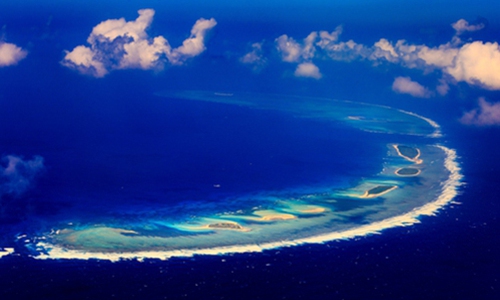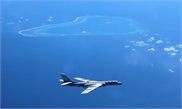
Xisha Islands in the South China Sea Photo: VCG
Dozens of US Navy vessels have been stricken by the coronavirus, yet by the end of April, US warships still frequently flexed their military muscle in the South China Sea. On Wednesday, two B-1B supersonic heavy bombers cruised over the skies to the northeast of the island of Taiwan. Such frequent moves made people think: What on earth does the US intend to do in South China Sea?
Since the US released its 2017 National Security Strategy, which labels China a "strategic competitor," the Pentagon has dramatically stepped up its efforts to provoke, deter and contain China.
Yet the deadly COVID-19 pandemic has upset US deployments just as the country became the global epicenter with the highest number of infections.
Four US nuclear-powered carriers, including USS Theodore Roosevelt, have been forced back to port after crew members contracted the novel coronavirus. The absence of these core forces of US global operations created a huge and instant "vacuum" in the Western Pacific.
Against the backdrop, why did the US military mount activities in the Western Pacific and the Taiwan Straits all of a sudden?
First, this is a quick and convenient way to demonstrate US' military existence in key areas of the Asia-Pacific regions.
Second, the US wants to support certain secessionist forces on the island of Taiwan, as the move meanwhile completes its tactical missions.
Spying and searching for underwater nuclear submarine activities have been one of US military's tasks in the region. After major US warships have been docked, the duty of detecting nuclear submarines can be conducted only by US military aircraft. Besides, US carrying out relevant operations can also boost the confidence of secessionist forces on the island of Taiwan and send them a signal that the US military has not abandoned their influence in the region even amidst the COVID-19 pandemic.
Third, Washington is showing Beijing its determination to maintain strategic deterrence in the South China Sea.
US military is aware that reconnaissance aircraft or anti-submarine aircraft cannot fully display strategic deterrence, so it deployed four B-1B Lancers and around 200 airmen to an Air Force Base to Guam, and sent two B-1B supersonic heavy bombers to cruise the Taiwan Straits.
The B-1B is valued for its stealth, high speed, and capabilities of carrying larger weapons payload. Obviously, Pentagon policymakers are attempting to use the strategic bombers as fresh instruments to strategically deter China in the Taiwan Straits
Some worry the mid-air collision between a Chinese fighter jet and a US spy plane in 2001 near Hainan Island may happen again, and that the US might deliberately create friction in places around China to divert Americans' attention from US mishandling of COVID-19. Such concerns are not superfluous. China has to make preparations. Washington is seemingly still aggressive and provocative. But, as a matter of fact, this it is just a bluff, and the Americans simply cannot fight and win an unjust war.
The author is a Beijing-based naval expert. opinion@globaltimes.com.cn

